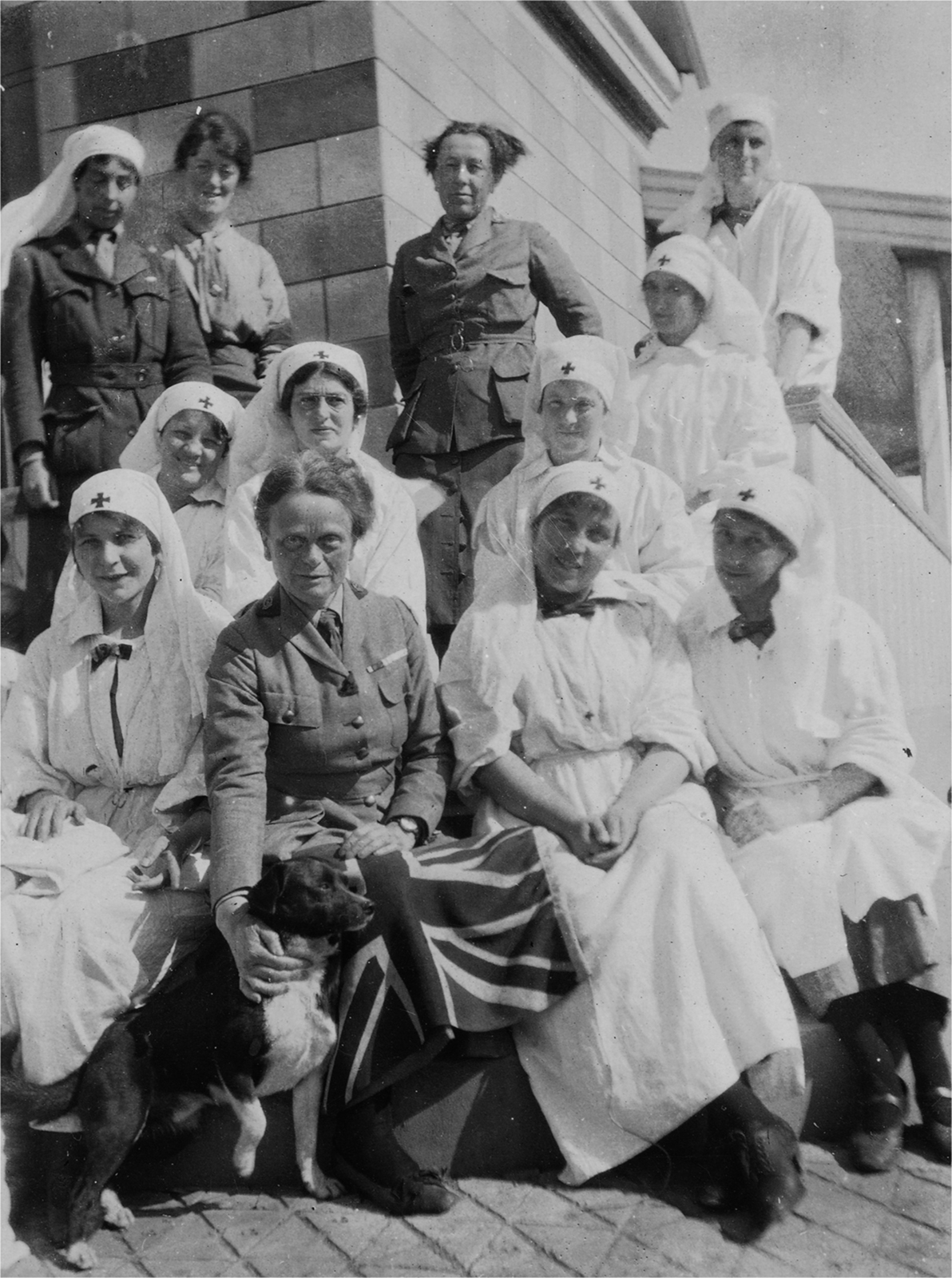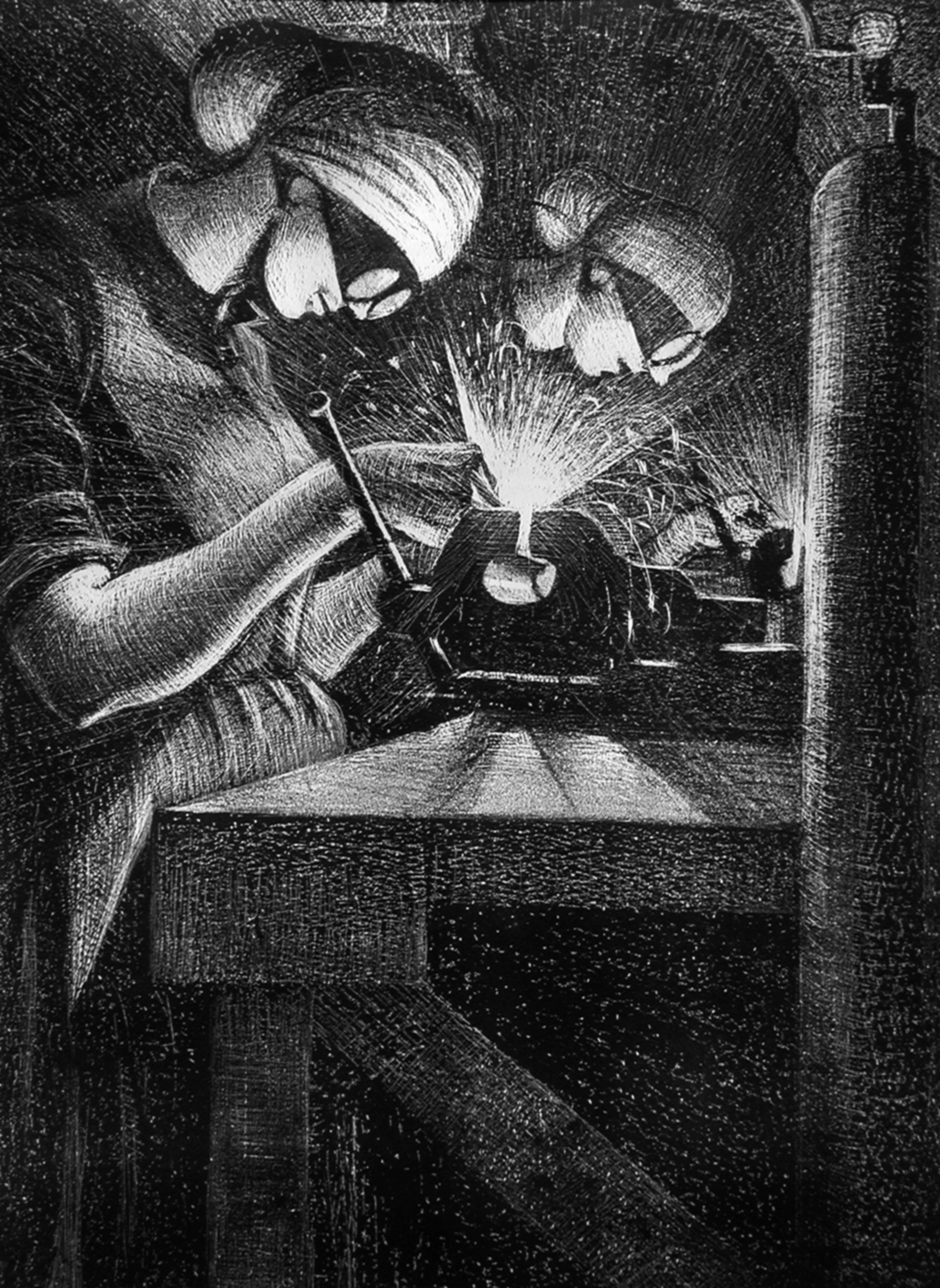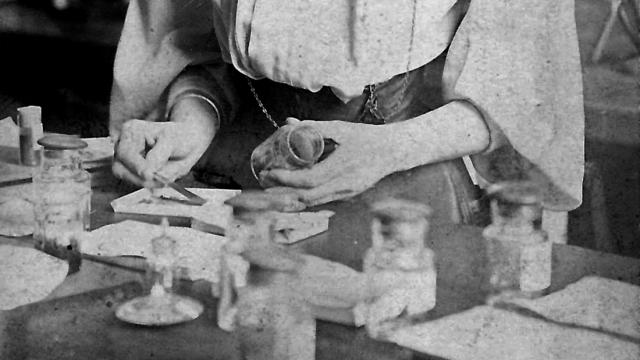During World War I, far away from the lines of battle, the UK was faced with a different crisis. As thousands of khaki-clad “Tommies” shipped off to the front, the British economy teetered on the cusp of grinding to a halt. With the men gone, the task of keeping the country’s lights on fell to women. British women flooded into munitions factories, hospitals, universities, and laboratories.
Martha Whiteley at Imperial College. Photo: Archives, Imperial College London
In the early 20th century, British women lacked the vote, as well as property rights and any real measure of autonomy. Middle and upper class women were still dismissed as “the fairer sex,” prone to hysteria and vapors, and expected to spend their days doting on husbands, keeping up a charming home, and raising children (poor and working class women, of course, already had to work).
The thought of a wave of English roses heading to work in dirty overalls sent shivers up scores of patriarchal spines — yet the imperial war machine called for someone to replace the men and boys fighting overseas, so off they went.

Elsie Inglis and some of her medical sisters, 1916 (Inglis standing on far left). Source: Courtesy of Edinburgh City Libraries and Information Services- Edinburgh Room.
2018 marks the centennial anniversary of women over 30 winning the right to vote in the United Kingdom (as well as the end of WWI), and author Patricia Fara’s new book, A Lab of One’s Own: Science and Suffrage in the First World War, deftly intertwines the twin narratives. Fara also gives us insight into what happened after the Tommies came home, the ignominious fate that befell these female trailblazers once their “superiors” returned to their posts and the way this era impacted the work of women scientists today.
She reflects upon the dissonance that these women felt as they designed and built weapons of war with the express aims of killing. In addition, Fara acknowledges that the picture is far from complete; the contributions and stories of the era’s women of colour and working class women are largely absent, as a result of both historical oversight and the fact that even the scant opportunities their middle and upper class white counterparts scrabbled for were miles out of their reach.
Fara stumbled upon this rich historical vein by chance, during a visit to Newnham College in Cambridge, one of the world’s oldest women’s universities. There, an archivist showed her a large handmade book listing the activities of students, graduates, and lecturers during World War — and Fara was bowled over by what she saw.
“To my amazement, inside I saw the names of doctors who operated at the Front, chemists who developed explosives and poison gases, biologists who researched into tropical diseases, and mathematicians recruited for intelligence work,” Fara told Gizmodo.
“Some of them died on service abroad; and many were rewarded with government or military honours, not only from Britain but also from Serbia, France, Russia, Belgium and Romania. The very first page included a physicist who ran hospital X-ray departments, a mathematician who travelled to Serbia as a doctor, and a scientist who survived a typhus epidemic abroad but died of pneumonia in London soon after returning home. Why, I asked myself, were these extraordinary women absent from the numerous books detailing the scientific, medical and technological advances spurred by the war?”

Christopher Nevinson, The Acetylene Welder, 1917, Lithograph. Source: Copyright David Cohen Fine Art/Mary Evans Picture Library.
We’re well accustomed to images of plucky factory workers and well-scrubbed nurses, but the contributions of middle and upper class women who constituted the bulk of the UK’s female scientific community are a far more esoteric subject.
“There were relatively few of these women, and it is extremely hard to dig out more than snippets of information about them,” Fara explained. “Back in the 1970s, feminist historians started writing about women — who after all are 50 per cent of the population — because they wanted to challenge the male-dominated accounts of battles on the Western Front. They rewrote war history by uncovering fascinating stories about all those thousands and thousands of women who were crucial for victory.”
Girls were generally discouraged from pursuing overly “intellectual” studies, so the ones who did buck convention and reached for a microscope or drafting table instead knitting needles were in for a bumpy ride from the onset.
“To succeed in maths, science, or engineering, women needed guts and determination as well as brains. At every single step, they confronted prejudice, mockery, and exclusion,” Fara said. “The first obstacle was persuading their parents to let them follow such an unladylike course, and sometimes that meant waiting until they were 21. Then, of course, they had to find the money. Some funding from women’s organisations was beginning to be available, but most students relied on family wealth.”
“Once at University, they were ridiculed by professors as well as the male students. They had to sit in special places at lectures, they were banned from many practical classes (especially anything to do with reproduction), and they could not enter the common rooms. And at Cambridge, they were not formally members of the University until 1948: when Philippa Fawcett came top in the maths exams, she was not even allowed to collect her degree.”
Once these young women made it through school or training and stepped blinking out into the professional arena, many found themselves adrift in yet another inhospitable environment. Paradoxically, even as women’s contributions to the war effort proved indispensable, an overwhelming number of their male counterparts did their absolute damnedest to discredit, disparage, and thwart women’s progress at every turn.
“I think these men were frightened. They wanted to protect their own positions and cling on to their assumptions of superiority,” Fara said. “When they saw that many of these women were cleverer and more competent than them, they defended themselves by attacking.”

Martha Whiteley at Imperial College. Photo: Archives, Imperial College London.
While working class women spent their days in munitions factories and shipyards, and men fought on the front lines, women chemists worked to achieve death on an even larger scale.
Ida Smedley helped set into motion the industrial-scale production of acetone, which was used for deadly explosives. An eight-woman team at Imperial College London led by Martha Whitley had an entire laboratory devoted to explosives and poisonous gases.
Whitley herself pioneered mustard gas, a noxious chemical agent that wracked the battlefields of Somme with agonised gasps (and has since morphed into its modern incarnation, tear gas — which was banned by the Geneva Convention in 2014, but has still found its way into the hands of cops and the lungs of protesters from Ferguson to Palestine).
Fara noted a lack of contemporary accounts bemoaning or reflecting upon their role in the slaughter, observing a certain kind of ambivalence, or even enthusiasm, as in the case of one Coventry lass who demanded extra training so she could manufacture Howitzers.
Fara uncovers at least one tangible record of them struggling with their role in the war. “The fact that I am using my life’s energy to destroy human souls gets on my soul. Yet on the other hand, I’m doing what I can to bring this horrible affair to an end,” one young projectile worker wrote in an essay for the factory’s magazine. “But once the war is over, never in Creation will I do the same thing again.”
While the well-to-do women of science, medicine, and industry who populate Fara’s research undoubtedly made important contributions in their fields, it’s also important to note that many of them were deeply flawed human beings. There were many who were prone to vituperative racism and classism. Middle and upper class women tended to look down upon poorer women who were engaged in less academic vocations and as more working class women became involved with war work, their haughty counterparts boorishly lamented the lack of available servants.
Women’s education campaigner Ethel Brilliana Tweedie flat-out told her domestic employees that they shouldn’t go off to work in the factories, but instead should stay at home to cook for women like her. Some — in the case of noted eugenicist and anti-feminist Arabella Kenealy — were downright monstrous, their scientific legacies tainted by racism and white supremacy.
After the Armistice was declared and Britain’s men began limping their way back home, it became immediately apparent that, despite everything that women had just accomplished, British society expected to return to its prewar patriarchal norms. Once the Tommies returned, many pioneering female scientists and medical professionals were pushed out of their labs — and back into the kitchen.
Women were actively discouraged from seeking work and bade to return home to care for their husbands (those who were able to find them — thanks to wartime casualties, women now outnumbered men) and raise the future sons and daughters of the Empire. By 1921, there were fewer women engaged in work outside the home than in 1911. Those who were able to secure employment found themselves relegated to the lowest-paying, least prestigious jobs, or were demoted from their wartime posts in favour of returning veterans with far less experience.
Women who were once hailed as the saviors of a nation were now regarded by many, according to Fara’s book, as “ruthless self-seekers, depriving men and their dependents of a livelihood.” By 1927, women were being openly warned that their job prospects in the medical, scientific, and industrial fields were dire; women’s university enrollment plummeted as prestigious universities like Cambridge and Oxford barred women from holding executive posts.
According to the men in charge, this was entirely women’s own fault — one academic opined that they should have “convinced thoughtless male colleagues of their worth” rather than expected equal treatment.
Class divisions were ironclad during that period, which is one more reason that the suffragists’ demands for equal pay for equal work often went over like a lead balloon — even within their own meeting halls.
“After an internal struggle for power in the main suffrage union, the women who thought that patriotism was more important came to dominate. After 1918, when women over 30 had the vote, the campaigns switched to claiming financial equality and independence,” Fara said. “There was disagreement: some women (I would have been on this side!) insisted they should be allowed to take on men’s jobs at the same pay rate; others thought they should be paid a salary for fulfilling their traditional domestic roles as mothers and nurturers.”
While that particular demand didn’t come to fruition, the notion of demanding a wage for domestic work endures. In her 1975 manifesto, Wages Against Housework, autonomist feminist Marxist thinker Silvia Federici spoke of gendered domestic labour — itself an extension of the nurturing role that so many women were and often still are expected to perform — as “the most subtle and mystified violence that capitalism has ever perpetrated against any section of the working class.”
She notes that, “When we struggle for wages we struggle unambiguously and directly against our social role,” which was precisely the argument levied against the wartime science and medical workers who protested against the systems that forced them to accept piss-poor wages (or no wages at all) for doing the same job a man had held prior to the war.
Despite the less-than-warm welcome they were given by their returning countrymen, the women in Fara’s book were ultimately able to notch significant achievements at home and overseas. However, the ethical questions surrounding their own contributions to the Great War’s staggering destruction of human lives remain a more difficult pill to swallow.
Fara (who has a physics degree) told me how much she admires Stoney in particular, but also made note of a few other favourite ghosts, like the elaborately monikered, snootily aloof Ethel Brilliana Tweedie — and one of my favourites, Helen the Botanist. “I strongly empathized with Helen Gwynne Vaughan, a botany professor who directed the women’s Army Corps in France,” she said.
“Wherever she went, she failed to fit in. Women resented her success and her beauty, while men thought that she was unfit to be in charge of the department. She never knew how to behave: she didn’t want to be touchy-feely feminine, but if she ran the lab with authority, she was accused of being authoritarian. She made me realise how tough it is to be a pioneer.”
